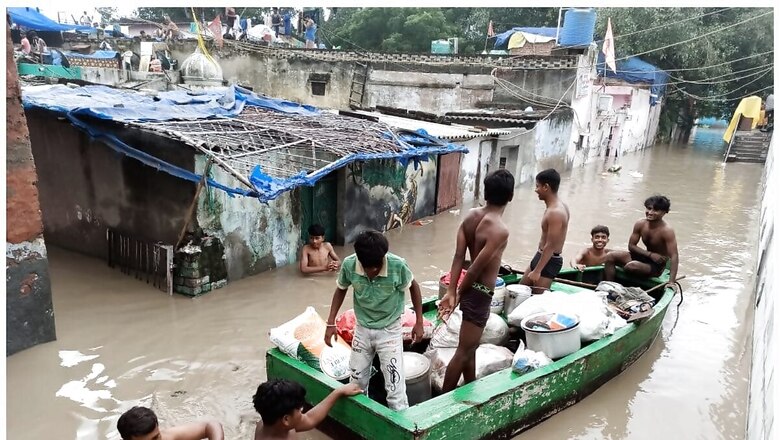
views
India is currently facing flood havoc and is leaving behind a trail of destruction and despair. While the monsoon season in India brings about 75 per cent of the annual rainfall, it is also a time of great variability and uncertainty in the country. As per the World Health Organisation, floods are increasing in frequency and intensity, and the frequency and intensity of extreme precipitation are expected to continue to increase due to climate change.
Delhi received excess rain on five out of eight days, from July 3 to 10. On July 9, it recorded 221.4 mm of rain, more than the 209.7 mm that is the average for all of July. This contributed to the flooding of large parts of the city. The Yamuna River overflowed its banks due to heavy rainfall in upstream states such as Himachal Pradesh and Haryana. The barrages in Delhi were unable to effectively regulate and redirect the river’s flow, leading to flooding of several areas along the river.
While this year floods are beginning to repeat the pattern of damage and destruction, let us understand this natural disaster in detail in Classes With News18.
What is a Flood?
A flood is defined as the overflow of a large amount of water on land, causing destruction. Sometimes a river might end up receiving extra water- either from heavy rains or because of other natural disasters. Due to this, the water overflows from its normal path in the river bed and onto the dry land. Water naturally flows from high areas to low-lying areas which means that low-lying areas may flood quickly.
Floods can happen suddenly or gradually over a long period. They can last up to many days or weeks or even longer, depending upon the type and extent of the flood. Out of all the natural disasters, floods are the most commonly seen all over India at certain times. It can cause widespread devastation, resulting in loss of life and damages to personal property and critical public health infrastructure.
Types of Floods
There are 3 common types of floods:
1. Flash floods: They are caused by rapid and excessive rainfall that raises water heights quickly, and rivers, streams, channels, or roads may be overtaken.
2. River floods: They are caused when consistent rain or snow melt forces a river to exceed capacity.
3. Coastal floods: They are caused by storm surges associated with tropical cyclones and tsunamis.
How Floods are Formed?
Flooding has a wide range of diverse causes. Here’s a list of factors that can lead to flooding:
1. Heavy Rainfall- A lot of heavy rainfall is the main cause of flooding. Whenever there is more rain than the drainage system can take, it can cause floods. This may cause flooding, including turbulent flash flooding. The monsoon season, which lasts from June to September, brings intense and erratic rainfall to different parts of the country.
2. Overflowing- The overflowing of water bodies like big rivers and lakes can cause flooding. This usually happens when there is more water upstream than usual, and as it flows downstream to the adjacent low-lying areas there is a burst and water gets into the land.
3. Dam Breaking- Dams are man-made structures that are used to hold water flowing down from a highland to a lowland. The power in the water is used to turn propellers to generate electricity. When there is a lot of rain, the water level will rise resulting in older infrastructure collapsing and causing overflow in the area. Excess water can also be intentionally released from the dam to prevent it from breaking and that can also cause floods.
4. Melting Snow and Ice- If a lot of snow melts quickly, it eventually has nowhere else to go but low-lying places. In the cold regions, heavy snow over the winter stays in solid form. Some mountains have an ice cap on them. Sometimes the ice suddenly melts when the temperature rises, resulting in a massive movement of water into dry land. This is usually called a snowmelt flood.
5. Strong Winds in Coastal Areas- Seawater can be carried by massive winds and hurricanes onto the dry coastal lands and cause flooding. This worsens if the winds carry rain with them. Sometimes even the water from the sea resulting from a tsunami can flow inland and cause damage.
Effects of Floods
Floods have a negative social, economic, and environmental impact on individuals as well as communities. The most immediate effect of a flood is the loss of life and destruction of buildings and other structures like bridges, sewerage systems, canals, etc.
Floods can also damage power generation and water supply. Lack of clean water combined with human sewage in flood waters raises the risk of waterborne diseases, which can include typhoid, cholera, and many other diseases depending upon the location of the flood. People who live in floodplains or non-resistant buildings, or lack warning systems and awareness of flooding hazards, are most vulnerable to floods.
Flood Management
1. Construction of Dams- Many dams and the reservoirs’ primary goal is flood control and protection. In order to provide a specific amount of room for flood waters to fill, many large dams include flood-control reservations. The level of a reservoir is kept below a particular elevation before the start of the rainy season or the summer melt season.
2. River Defences- Rivers are carefully controlled because they are prone to flooding in many nations. Levees, reservoirs, and weirs are used as defenses to stop rivers from overflowing their banks and prevent flooding.
3. Floodplains and Groundwater Replenishment- If one redirects extra water onto terrain that can soak it up, groundwater can be refilled.

















Comments
0 comment